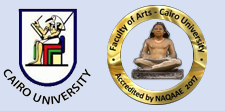عنوان المقال عربي
الترجمة بوصفها مثاقفة، جدلية المتن والهامش بين الإقحام والإفهام
Document Type
Original Study
Keywords English
translation, ؛ Acculturation؛ footnote؛ translation strategies
كلمات مفتاحية عربي
الترجمة, المثاقفة, الهامش, إستراتيجيات الترجمة
Abstract English
Is the footnote really regarded as an important strategy of translation? This study is meant to regarding the translation footnote as an available space that could present a lot of spotlights and interpretations of the translation itself, in a way that strengthens the translation readability and keeps the identity of the original text, with no interference. “Do the quality and quantity of footnotes of literary translations differ from those of the human sciences?These questions and other more have been dealt with in 50 translated books published by the National Translation Centre in Cairo. About fifty percent of it deals with translations of human sciences, the rest are mainly various literary translations. The study, also, includes statistics of translator’s interference. Therefore, it points out the information presented in those books that reveals the purpose of the translation and whether, or not, does the translator adopt certain translation strategies. Furthermore, it reveals if the translator is keen on presenting cultural content to the targeted reader in literary translations.The conclusion of this study shows that the footnotes of literary translations exceeded those of human sciences, in about two doubles.The study explains this considering feature of literary contents in creative works. That’s why the footnote is essential in explaining the content and translation.
الملخص العربي
الإحالة إستراتيجية ترجمية مهمة؟ هل بإمکانها أن تقلل الفجوة بين الترجمتين الأمينة والحرة؟ حيث ترى هذه الدراسة أنّ الحاشية الترجمية مساحةٌ متاحة لتقديم الکثير من الإضاءات والتأويلات عن موضوع الترجمة نفسه بما يعزز مقروئيتها ويظل يحتفظ لمتن النص الأصلي بهويته دون تدخل. هل تختلف طبيعة الإحالة کمًّا وکيفًا في ترجمات العلوم الإنسانية عنها في الترجمات الأدبية؟ وأين المواضع التي يمکن الادعاء أنه أمامها تصبح الحاشية ملزمة للمترجم؟ وما الذي يحدد تلک المواضع أو من الذي يحددها؟ هل النص الأصلي هو الذي يحدها أم فهم المترجم وتأويله باعتباره القارئ الأول للنص الهدف؟ هذه الأسئلة وغيرها وضعتها الدراسة موضع التطبيق على عدد من الترجمات صدرت کلها عن المرکز القومي للترجمة بالقاهرة: خمسة وعشرين ترجمة في العلوم الإنسانية وخمسة وعشرين ترجمة أدبية متنوعة، وقد تم إحصاء تدخلات المترجمين في کل منها وکذلک تحديد طبيعة تلک الإحالات ومدى ما تقدمه من معلومات تکشف عن مغزى الترجمة ومدى تبني المترجم إستراتيجيات ترجمية بعينها، وکذلک مدى حرصه على نقل المحتويات الثقافية للقارئ المستهدف في الترجمات الأدبية على وجه الخصوص. وقد تبين من الدراسة أنّ التدخلات الإحالية في الترجمات الأدبية تتفوق بمقدار الضعف على تدخلات المترجمين في العلوم الإنسانية، وفسرت الدراسة ذلک استنادًا إلى خصوصية المحتويات الثقافية في الأعمال الإبداعية؛ الأمر الذي يتطلب تدخلات إحالية شارحة. وختامًا، خرجت الدراسة بنتيجة مؤداها إن الهامش أو الحاشية الترجمية آلية بالغة الأهمية ولديها الکثير لتقدمه للمترجمين والقراء وللنصين الأصلي والمترجَم سواء بسواء.
Recommended Citation
Abd Elghaffar, Mahmoud Ahmed
(2022)
"Translation as Acculturation, The controversy of the original text and the footnote between enforcing and understanding,"
Journal of the Faculty of Arts (JFA): Vol. 82:
Iss.
4, Article 15.
DOI: 10.21608/jarts.2022.127794.1233
Available at:
https://jfa.cu.edu.eg/journal/vol82/iss4/15
Digital Object Identifier (DOI)
10.21608/jarts.2022.127794.1233
Accept Date
2022-05-24
Publication Date
10-1-2022

